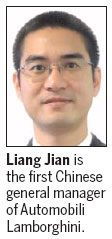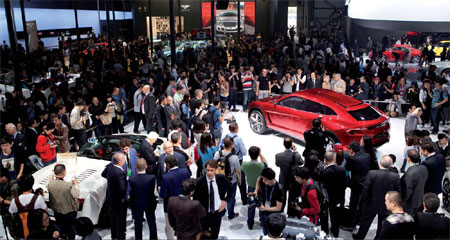Supercars with Chinese face
Updated: 2012-10-12 11:01
By Wang Chao (China Daily)
|
|||||||||||
|
Automobili Lamborghini at the Beijing Auto Show in April. The luxury car maker's sales in China accounted for 20 percent of its global sales last year. Provided to China Daily |
Lamborghini puts local talent in driving seat to maintain market momentum
As Automobili Lamborghini prepares to celebrate its 50th anniversary next year, the Italian sports car manufacturer, which roared into China in 2005, is looking to boost sales by hiring a local general manager to spearhead operations in China.
 |
The appointment comes at a time when the Chinese market is showing strong momentum, with sales in 2011 of 342 vehicles - a year-on-year growth of 70 percent, accounting for 20 percent of its global sales.
This was demonstrated with the first launch of a new model in China, the Urus SUV during the Beijing motor show, and now the luxury car maker has gone for local talent Liang Jian to head its advances in China.
Liang majored in international business at the Guangdong University of Foreign Studies and obtained his master's in international marketing management from Leeds University in the United Kingdom.
Before joining Lamborghini a couple of months ago, he was head of sales and marketing for the SCAS Investment Group in Shenzhen, working on behalf of car and yacht manufacturers until 2005, when he became regional sales director for Mercedes-Benz China.
Analysts say a Chinese face leading an overseas company can help it get closer to the Chinese nouveau riche who are eager to show off their wealth.
"I guess my biggest advantage is that I speak Chinese to my clients," says Liang, who grew up in Guangdong province. "So communication and management will be more efficient. And, of course, clients will be happy to see a Chinese general manager greeting them."
Liang says localization is essential for a car company, even for an international super-luxury brand.
During the Shenzhen auto show in June, Lamborghini launched its limited Gallardo LP560-4 Gold Edition, of which only 10 were made - exclusively for sale in China.
Other "local" customization includes red stitching on the seats, which Chinese people believe to be auspicious, and personal names embroidered on accessories. Liang says one female customer requested her car's color to be the same as her nail lacquer.
Localization requires a good knowledge of its customers, and Liang has amassed that from his 10 years in sales and marketing in the luxury car sector.
Chinese customers of luxury cars are generally five to eight years younger than customers in other countries, and mainly run businesses, Liang says.
"They have accumulated their wealth quickly because of the quick rise of the Chinese economy," Liang says. And they are very generous in rewarding themselves - especially the young entrepreneurs.
"And the young generation's indulgence affects the older generations. Sometimes the son will bring the father and introduce him to the sports car."
To get his hands on, say, a 6.5L Aventador LP700-4 model in China, dad will be looking at a price tag of 6.27 million yuan ($997,600, 766,800 euros). And if he decides to buy it, he will have to wait 18 months for delivery.
Clients also differ from one place to another within China. While those in the north prefer darker colors, people on the southeast coast go for bright and flashy hues, Liang says.
The ebb in the Chinese auto market has affected the premium sector too, however, and Lamborghini's 70 percent growth rate in 2011 may slow down to between 10 and 15 percent this year, Liang says.
But the super-luxury brands are more insulated from the macro-economic conditions, he says, as the very affluent have accumulated such a vast fortune that they can continue to spend lavishly.
The great resilience of luxury cars can be seen in the sales figures. Last year, the number of imported-car dealers in China increased by 40 percent to more than 1,200, according to China State Administration for Industry and Commerce.
The Lamborghini brand was bought by Audi AG in 1998, becoming a member of the Volkswagen family, which also includes Porsche and Bentley.
Auto consulting company LMC Automotive estimates that sales of luxury cars this year will exceed 1.1 million, compared with 970,000 last year, and the number will double by 2015.
Another bonus for a super-premium vehicle is that there is no direct competitor, says Christian Mastro, general manager of Automobili Lamborghini Asia-Pacific.
"Super-rich people can have a fleet of cars in their garage, as long as they like them," he says.
The decline in growth number is also because of the relatively small and low demand of a few hundred units a year, Liang says.
"So once our target customers have bought Lamborghinis, it is very hard for us to generate as high a growth rate as when we first entered China.
"In the long run, the growth rate will level out and stabilize, but China no doubt will continue to be one of the most important markets for Lamborghini."
Unlike Audi and Mercedes-Benz, which focus on the larger group of upper middle-class, Lamborghini targets a much smaller group, and is therefore more dependent on local dealers who have a better knowledge of the elite bands.
Some dealers not only sell Lamborghini, but also private jets and yachts.
The brand has already set up 14 dealerships in the first-tier cities, and aims to establish another six by the end of the year, mainly in central and western cities such as Xi'an and Changsha, Liang says.
"The market frontier is moving westward," he says. "In traditional markets, like in coastal cities, the sales volume is very stable, while in the second to third-tier cities, the base number is small, but the growth potential is huge."
wangchao@chinadaily.com.cn
(China Daily 10/12/2012 page21)
Today's Top News
Rescuers race against time for quake victims
Telecom workers restore links
Coal mine blast kills 18 in Jilin
Intl scholarship puts China on the map
More bird flu patients discharged
Gold loses sheen, but still a safe bet
US 'turns blind eye to human rights'
Telecom workers restore links
Hot Topics
Lunar probe , China growth forecasts, Emission rules get tougher, China seen through 'colored lens', International board,
Editor's Picks

|

|

|

|

|

|






